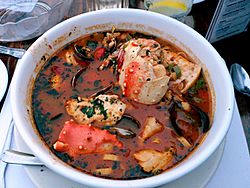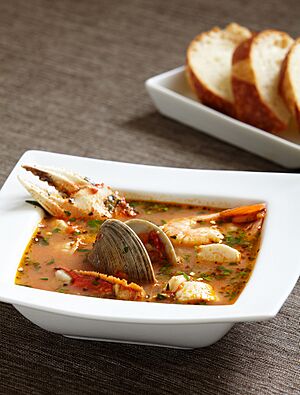Cioppino facts for kids
 |
|
| Type | Fish stew |
|---|---|
| Place of origin | United States |
| Region or state | San Francisco |
| Main ingredients | Seafood (Dungeness crab, clams, shrimp, scallops, squid, mussels, fish), tomatoes, wine |
Cioppino is a yummy fish stew that first came from San Francisco, California. It's an Italian-American dish. It's like many other fish soups and stews found in Italian cuisine.
What is Cioppino?
Cioppino is usually made with fresh seafood caught that day. In San Francisco, this often means Dungeness crab, clams, shrimp, scallops, squid, mussels, and different kinds of fish. All this seafood comes from the Pacific Ocean.
The seafood is cooked in a tasty sauce. This sauce is made with fresh tomatoes and wine.
You can eat Cioppino with toasted bread. This is often local sourdough or French bread. You can dip the bread into the delicious sauce. It's a bit like eating pasta with a sauce.
The Story of Cioppino
Cioppino was created a long time ago, in the late 1800s. It was made by Italian immigrants who fished near Meiggs Wharf in San Francisco. Many of these fishermen came from a port city in Italy called Genoa. They lived in the North Beach area.
Here's how the dish got started: If a fisherman didn't catch any fish, they would walk around with a pot. They would ask other fishermen to share some of their catch. Whatever seafood ended up in the pot became their Cioppino. The fishermen who shared expected the same help if they had a bad day fishing later on.
Over time, Cioppino became a popular dish. It was served in many Italian restaurants that opened in San Francisco.
The name "Cioppino" comes from an Italian word, ciuppin. This is the name of a classic soup from a region in Italy called Liguria. That soup tastes similar to Cioppino. But it has less tomato, and the seafood is cooked until it's very soft.
Cioppino is also related to other seafood stews from Italy. These include cacciucco from Tuscany and brodetto di pesce from Abruzzo. You can find similar seafood stews in many coastal places around the Mediterranean Sea. Some examples are suquet de peix from Catalan-speaking regions and bouillabaisse from Provence.
The first time Cioppino was written about was in 1901. A recipe for a stew called "chespini" appeared in The San Francisco Call newspaper. The name "Cioppino" first showed up in a cookbook in 1906. This cookbook, The Refugee's Cookbook, helped raise money for people affected by the big earthquake and fire in San Francisco in 1906.
How Cioppino is Served
When you get Cioppino, the seafood is usually cooked and served in its shell. This includes the crab, which is often cut in half or into quarters. Because of this, you might need special tools to eat it. These often include a crab fork and a cracker.
Some restaurants might even give you a bib! This helps keep your clothes clean from any splashes. You might also get a damp napkin and an extra bowl for the empty shells.
There's also a version called "lazy man's cioppino." With this one, the shells are already cracked or removed for you. This makes it easier to eat!
See also
 In Spanish: Cioppino para niños
In Spanish: Cioppino para niños


